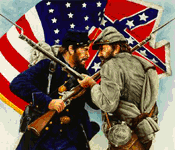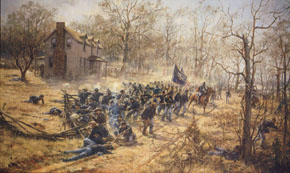 |
Civil War Battles |
|
State War Records |
| AL - AK - AZ - AR - CA - CO - CT - DE - FL - GA - HI - ID - IL - IN - IA - KS - KY - LA - MA - MD - ME - MI - MN - MS - MO - MT - NE - NV - NH - NJ - NM - NY - NC - ND - OH - OK - OR - PA - RI - SC - SD - TN - TX - UT - VT - VA - WA - WV - WI - WY |
The Battle of Prairie Grove
December 7, 1862 in Fayetteville, Arkansas
 |
|||||||||||||||||
|
Hindman's force gathered at Fort Smith, Arkansas and sent out approximately 2,000 cavalry under General John S. Marmaduke to harass Blunt's forces and screen the main Confederate force.
Unexpectedly Blunt moved forward with his 5,000 men and 30 artillery pieces to meet Marmaduke. The two clashed in a nine-hour running battle known as the Battle of Cane Hill on 28 November 1862. Marmaduke was pushed back but Blunt found himself 35 miles deeper into Arkansas and that much farther from the remainder of his army.
On 3 December Hindman started moving his main body of 11,000 poorly equipped men and 22 cannon across the Boston Mountains toward Blunt's division. Blunt, disturbed by his precarious position, telegraphed Herron and ordered him to march immediately to his support from Springfield. Blunt did not fall back towards Missouri but instead set up defensive positions around Cane Hill to wait for Herron.
Hindman's intention was for Marmaduke's cavalry to strike Blunt from the south as a diversion. Once Blunt was engaged Hindman intended to hit him on the flank from the east.
On 6 December Hindman learned of Herron's movement out of Springfield and realized that he could not attack Blunt from the east as planned. He decided that he would move north and intercept Herron before he could arrive to reinforce Blunt. During the night of 6 and 7 December Hindman bypassed Blunt's force and moved northward with Marmaduke's cavalry in the fore.
Meanwhile, Herron's divisions had performed an amazing forced march to come to Blunt's rescue and met Marmaduke's probing cavalry south of Fayetteville, Arkansas.
Hindman's characteristically aggressive nature seems to have failed him at this moment. Afraid that Blunt would be able to attack his rear, and facing Herron to the north, Hindman chose instead to set up a defensive position atop a line of low hills near Prairie Grove, Arkansas.
The battle opened on the morning of 7 December with Union General Herron crossing the river and deploying his footsore troops on Hindman's right. Herron opened an intense two hour artillery barrage on the Confederate position singling out individual Confederate cannon and concentrating on taking them out of action one at a time. By noon, the devastating barrage had disabled most of the Confederate artillery and forced many of the Confederate troops to shelter on the reverse slopes.
Seeing the effect of his artillery, Herron ordered an advance on the hill rather than waiting for Blunt to arrive. When his men arrived on the hill they found themselves under a fierce Confederate counterattack from three sides by Maramaduke and General Francis A. Shoup. Half of the attacking Federals were wounded or killed within minutes, most near the Borden House.
As the surviving Federals rolled back down the hill toward the safety of Union lines Confederate soldiers spontaneously pursued and attempt to break Herron's lines. Herron's artillery loaded with canister caused terrible damage to the unorganized Confederates and repulsed their attack.
Meanwhile, Blunt realized that Hindman had gotten past his flank and intercepted Herron. Furious, he ordered his men to march to the sound of the guns. Blunt's forces arrived on the field just as Hindman was ordering another attack on Herron's forces. Blunt's division slammed into the surprised Confederates and drove them back onto the hill. The heaviest casualties of the battle were felt during this attack by the 10th Missouri Confederate Infantry, which was caught in the open, at the flank of the confederate forces.
During the night of 7 December and 8 December Blunt began to call up his reserves. Hindman on the other hand had no reserves remaining, was low on ammunition and food, and had lost much of his artillery firepower. Hindman had no choice but to withdraw under cover of darkness back towards Van Buren, Arkansas. The Confederates reached Van Buren on 10 December, demoralized, footsore, and ragged.
By 29 December Blunt and Herron would threaten Hindman at his Van Buren sanctuary and drive him from northwest Arkansas permanently.
Federal forces suffered 1,251 casualties and Confederate forces suffered 1,317 casualties. In addition, Confederate forces suffered from severe demoralization and lost many conscript soldiers during and after the campaign.
Though the battle was a tactical draw, it was a strategic victory for the Federal army as they remained in possession of the battlefield and Confederate fortunes in northwest Arkansas declined markedly from that point on.
Books on The Battle of Prairie Grove & the Prairie Grove Campaign
are available from Amazon.com
